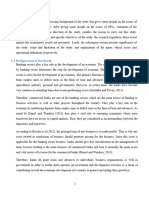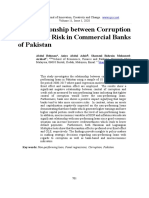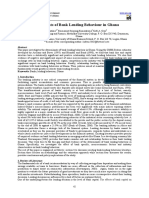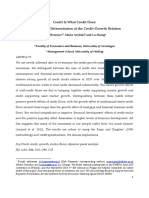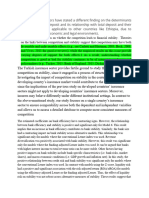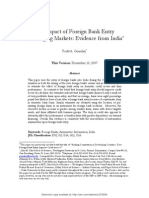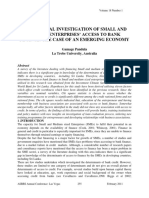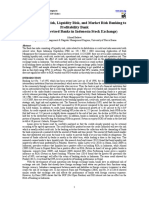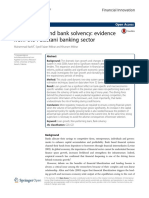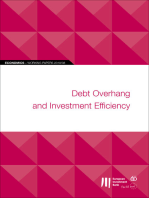0 ratings0% found this document useful (0 votes)
32 views10 Fawad Ahmed
10 Fawad Ahmed
Uploaded by
Nicholas BryanCorruption and information sharing may impact non-performing loans. The study investigates the effect of corruption at the macroeconomic and institutional levels on non-performing loans in Pakistan from 2001-2010. It also examines how information sharing between financial institutions affects non-performing loans. The results found no significant association between corruption, information sharing, and non-performing loans. However, based on literature, reducing corrupt practices such as through proper credit allocation, supervision, and monitoring could help lower non-performing loans.
Copyright:
© All Rights Reserved
Available Formats
Download as PDF, TXT or read online from Scribd
10 Fawad Ahmed
10 Fawad Ahmed
Uploaded by
Nicholas Bryan0 ratings0% found this document useful (0 votes)
32 views12 pagesCorruption and information sharing may impact non-performing loans. The study investigates the effect of corruption at the macroeconomic and institutional levels on non-performing loans in Pakistan from 2001-2010. It also examines how information sharing between financial institutions affects non-performing loans. The results found no significant association between corruption, information sharing, and non-performing loans. However, based on literature, reducing corrupt practices such as through proper credit allocation, supervision, and monitoring could help lower non-performing loans.
Original Description:
xyx
Copyright
© © All Rights Reserved
Available Formats
PDF, TXT or read online from Scribd
Share this document
Did you find this document useful?
Is this content inappropriate?
Corruption and information sharing may impact non-performing loans. The study investigates the effect of corruption at the macroeconomic and institutional levels on non-performing loans in Pakistan from 2001-2010. It also examines how information sharing between financial institutions affects non-performing loans. The results found no significant association between corruption, information sharing, and non-performing loans. However, based on literature, reducing corrupt practices such as through proper credit allocation, supervision, and monitoring could help lower non-performing loans.
Copyright:
© All Rights Reserved
Available Formats
Download as PDF, TXT or read online from Scribd
Download as pdf or txt
0 ratings0% found this document useful (0 votes)
32 views12 pages10 Fawad Ahmed
10 Fawad Ahmed
Uploaded by
Nicholas BryanCorruption and information sharing may impact non-performing loans. The study investigates the effect of corruption at the macroeconomic and institutional levels on non-performing loans in Pakistan from 2001-2010. It also examines how information sharing between financial institutions affects non-performing loans. The results found no significant association between corruption, information sharing, and non-performing loans. However, based on literature, reducing corrupt practices such as through proper credit allocation, supervision, and monitoring could help lower non-performing loans.
Copyright:
© All Rights Reserved
Available Formats
Download as PDF, TXT or read online from Scribd
Download as pdf or txt
You are on page 1of 12
87
Business Systems Research Vol. 4 No. 1 / March 2013
Corruption and Information Sharing as
Determinants of Non-Performing Loans
Fawad Ahmad
Department of Management Sciences, Iqra National University, Peshawar, Pakistan
Abstract
Background: There are several factors that lead to the growth or decline of the non-
performing loans, such as macroeconomic variables and bank specific variables, banks
ownership structure, corruption and information sharing. Among them one of the main
factors that affect the non-performing loans are the corruption. In developing countries
corruption plays very important role in the growth of non-performing loans. Objectives: This
study investigates the impact of corruption at economy level and institution level on the non-
performing loans. This study also examines the association of information sharing between
depositors, lenders and financial institutions. Methods/Approach: The current study used time
series data over the period of 2001 to 2010 and employed OLS method. Results: The results
provide no significant association of corruption and information sharing with non-performing
loans. Conclusions: The results suggest no significant impact of corruption on non-performing
loans because of the nature of the data used, but as literature provides significant impact of
corruption on non-performing loans, therefore State Bank of Pakistan and commercial banks
can reduce the level of non-performing loans by reducing the chance of corrupt practices
by following the rules and regulation of credit allocation, supervision and loan monitoring.
Key words: non-performing loans, corruption, information sharing, supervision, control and
performance
JEL classification: G20, K4, P2
Paper type: Research article
Received: 8, November, 2012
Revised: 4, March, 2013
Accepted: 6, April, 2013
Citation: Ahmad, F. (2013). Corruption and Information Sharing as Determinants of Non-
Performing Loans , Business Systems Research, Vol. 4, No. 1, pp. 87-98.
DOI: 10.2478/bsrj-2013-0008
Introduction
In order to achieve the recovery of global economy, the consumer and investor confidence
in the markets must be restored. However, this process is very slow leaving many small
economies, industries and even small firms struggling to attain break even. The impact of
Global Financial Crisis (GFC) and recession in developing countries was most evident in 2009.
Like in other Asian countries, GFC expressed its effects on the real sector of Pakistan
economy. This partial affect was due to the decrease in the exports resulting from the
recession and liquidity crunch in the global financial market, which lead to the withdrawal of
foreign investment from Pakistan and depreciation of the local currency. Similarly, increase in
global oil prices, energy crisis, underutilization of production facilities, high per unit cost,
circular debts, decline in capital flow and growth, budget deficit and growth in corruption
played important role in slowing down the recovery of economy. All these pressures on the
economy and industry translated in the inability of households and firms to repay their debts,
consequently resulting in the growth of Non-performing loans (NPLs). The rapid growth in NPLs
poses challenges on the flexibility of banking sector to increase their provisions for NPLs. This
affected the dividend payments, resulting in the decline of stock prices.
88
Business Systems Research Vol. 4 No. 1 / March 2013
Increase in NPLs is alarming sign for any country banking sector but growth in profitability
can help in putting them out of sight. Same is the case with Pakistani banking sector, latest
banking data collected by State Bank of Pakistan (SBP) shows that default rates has
increased with rapid rate over the last few years. This upward trend started at the beginning
of 2005 and lasted till the end of 2010. The NPLs to total bank lending was 6.7 percent in 2005
which jumped to 14.3 percent at the end of 2010, showing growth of more than double
during last five years. Whereas during the same period banks have shown growth in
profitability, but despite of this banking sector struggled and invested mostly in government
risk free securities. The main reason for growth in profitability was the higher spread earned by
the banks, which was greater than 7 percent. The existing literature has shown that rapid
growth in NPLs leads to the banking crisis (Gonzlez, 1999). The GFC and recession in
economy results in the growth of household and firms default rates, thus the quality of loan
can be used to control and prevent the occurrence of banking crisis. The regulatory
authorities can monitor the quality of loan and use it as early warning indicator to prevent the
banking crisis.
There are several factors that lead to the growth or decline of the NPLs, such as
macroeconomic variables and bank specific variables, banks ownership structure, corruption
and information sharing. Among them one of the main factors that affect the NPLs is the
corruption. In developing countries corruption play very important role in the growth of NPLs.
This corruption can be at macroeconomic level, political corruption and inside institutions
corruption. Existing studies have found significant positive impact of corruption on the growth
of NPLs (Goel and Hasan, 2011). This growth in NPLs can be because of the political influence
of the lenders (Khwaja and Mian, 2005), loans through bribes or banks official corruption,
lenient credit policies, low opportunity cost of defaults, weak regulatory and supervisory
authorities, corruption in financial institutions, failure of law implementation authorities, weak
legal system of the country and information asymmetry between lenders and banks.
Therefore the main goal of current study is to investigate the explanatory power of corruption
(macro level and institution level) and information sharing as determinants of NPLs. This study
used two indexes for the corruption measurement and one index for the information sharing.
In this study 10 years time series data of NPLs ratio and five variables were used and ordinary
least square method was employed to get the empirical results.
Literature review and hypothesis
The existing literature relating effects of corruption on the banks performance is limited. Only
few studies have investigated the impact of corruption on the banks performance. Therefore
to develop theoretical background for this study literature on corruption and its impacts on
the bank lending and financial institutions performance are used. Only one recent study has
empirically investigated the impact of corruption on NPLs (Goel and Hasan, 2011). In this
study the link between NPLs and corruption is established by using existing literature on the
relationship between corruption, non-financial institutions, legal system, protection to banks,
banks lending and NPLs.
The key argument relating how corruption may hamper the bank lending can be given
form the La Porta et al., (1997) study in which they presented the law and finance theory.
Strong supervisory and legal institutions can increase the banks lending by ensuring the
fulfillment of loan contacts, consequently providing the banks protection against the default
of debtors. The enforcement of legal contracts by the legal institutions stimulates the
willingness of the banks to lend more. Because banks are ensured that incase of debtors
default, banks have the legal power laid down by legal institutions, to take actions in order to
recover credit amount. These actions may include forcing the debtors to repay credit,
disposing off collateral, and even take over of debtors businesses incase of corporate loans.
Thus, the power to take action and imposition of legal contacts by the legal institutions
increases the willingness and reduces the riskiness of the banks. Whereas, in case of
corruption in the legal institution banks are unsure regarding the imposition and fulfillment of
legal contracts and recovery of credits on debtors default. Thus uncertainty regarding the
recovery of credit due to corruption results in the reduction of loans by the banks and also
increases in the riskiness of banks in the form of NPLs.
89
Business Systems Research Vol. 4 No. 1 / March 2013
Existing empirical studies supported the fact that strong laws, supervision and legal
institutions leads to improvement in banks financial records (reduction of loan losses) and
growth in banks lending. For instance, La Porta et al., (1997) used 49 countries data and
showed that the capital markets of the countries are smaller that are having poor investor
protection laws. In other words they argued that poor protection laws do not provide the
banks assurance that their credit will be repaid or not, thus lending by the banks is at lower
side in such countries. Because of this reason the capital markets of such countries are less
developed. On the other hand the countries with well developed legal institution and laws
have well developed capital markets because banks has the assurance that they will get
their credit back even in case of debtors default. Thus strong laws and legal institutions
contribute to the increase in lending (arlija and Harc, 2012).
Djankov et al., (2007) used 129 countries credit data over the period of 25 years. Their
study presented three main results; among them two are relevant to our study. First, they
proved that information sharing among the institutions and legal protection to the creditor
results in the development of credit markets by enhancing the credit growth. Second, they
argued that the legal protection rights for creditors are different in both poor and rich
countries. In rich countries strong legal protection rights are given to the creditors as
compared to the poor countries where creditors have weak or no legal protection rights.
Both these results show that strong legal protection rights results in the increase in banks
lending. These results also suggest that the countries with strong legal protection can have
lower levels of NPLs because of the strong legal protection and strict laws and regulations by
the regulatory authorities. Similarly the poor countries where legal system is not very strong like
Pakistan, banks in order to earn profit may lend to the low quality borrowers which takes the
advantage of weak and corrupt legal system by not repaying loan. Thus the countries with
weak legal system may have lower lending and higher NPLs. Barth et al., (2009) extended the
work of Djankov et al., (2007) and find information sharing and competition play significant
role in decreasing the lending corruption. They also find that information sharing increases the
bank competition and reduces the banks curtail. They also argued that strong legal system
also enhances the firm competition and reduces the corruption lending.
Qian and Strahan (2007) investigated the impact of different legal and institutional
protection rights on the nature of ownership and banks terms of loans. They find that strong
legal protections allow the banks to lend one specific sector or specific group of debtors.
Similarly, strong protections reduce the riskiness of the banks and enable them to lend for long
period of time and at lower interest rates.
Above arguments are relating the corruption in the judiciary and legal institutions, whereas
another form of corruption that has effect on the bank credit is corruption by the bank official
in the form of bribes received from the debtors. The bribes are given to the bank officials in
order to favor debtors for lending money. This fact is clearly given in Levin and Satarov (2000)
study that during 1990s in order to get loan Russian people used to give envelopes full of
money to banks officials in order to get loans. This practice was part of Russian system at that
time. Levin and Satarov (2000) also reported the criminal cases that were filled against the
employees of banks during 1990s. In China during 2005, 461 similar corruption cases were
registered; each case involved at least million Yuan corruption Barth et al., (2009). The
corruption by the banks official can have both positive and negative impact on the bank
lending.
The negative impact on bank lending is through the increase in the amount demanded
by officials for allocating credit. This amount act as a cost for the debtors, if this cost will
increase consequently the borrowing will reduce. The evidence relating negative relationship
is provided by the World Business Environment Survey (WBES) conducted by World Bank. This
survey used a questionnaire targeted the firms mangers to enquire whether banks mangers
act as an obstacle in credit growth. Batra et al., (2004) conducted a research based on the
WBES data and observed that 20% to 30% firms other than OECD countries considers bank
officials as the moderator or major obstacle in the credit growth. Similarly, Beck et al., (2006)
find negative relation between corruption and bank lending and argued that corruption of
banking official is minor obstacle in lending. Their study was based on the WBES data and
investigated the financing obstacles determinants by using 80 countries sample. They
observed that half of the surveyed firms did not find corruptions in banks as an obstacle in
90
Business Systems Research Vol. 4 No. 1 / March 2013
lending. Thus it can be concluded from their results that corruption of banking officials can
not be considered as determinant of obstacles in bank lending.
The above argument shows that corruption hampers the bank lending but corruption can
also stimulate the growth of credit. The bribes by the debtors to the bank officials increase
their chances of obtaining loan, thus corruption encourages banks lending.
The incentives to offer bribes increases for the borrower when banks are more risk averse.
Risk aversion refers to unwillingness of banks in granting credits, as banks risk aversion
increases consequently more loan applications are rejected. As a result chances to get loan
through bribes increases. A theoretical evidence to support the positive relationship between
lending and corruption was given by Stiglitz and Weiss (1981). They argued that adverse loan
selection due to asymmetry of information between debtor and banks results into credit
rationing. The credit rationing shows that debtors are willing to pay more than the credit rate,
thus it provides incentive to debtor for paying bribes to get loan. In case of credit rationing
banks avoids the adverse selection and grant loan to those who can pay more. Only bad
borrowers are able to pay more thus avoidance of adverse selection attracts bad borrowers.
According to adverse selection mechanism, only risky borrowers have incentives to pay more
and to get loans, not the safe borrowers. Thus, corruption by the banks officials mi ght only
increase the bad loans of the banks.
The positive relation between corruption and lending is supported by Levin and Satarov
(2000) they observe that corruptions in banks occure through bribes to bank officials for
providing loans. Lizal and Kocenda (2001) argued that in Czech Republic corruption in
lending is occured by allocating loans to the non-existent or unreasonable projects.
From an empirical point of view, only two studies are providing relation between the
corruption and bank lending. First, Detragiache et al., (2008) investigated foreign bank
penetration impact on the banks lending. Their study finds negative relationship between
corruption and bank lending by using corruption as control variables. Second, Weill (2011)
conducted empirical study to find the impact of corruption on bank lending in Russia. Results
showed that corruption decreases the bank lending in Russia. In order to find the reason of
this negative relation, Weill investigated whether negative relation is due to banks risk
aversion or not, but find no support regarding the banks risk aversion impact on decrease in
lending. Thus Weill argued that Russian government can increase the bank lending in order to
increase the growth of country by controlling the corruption in country.
The only theoretical and empirical study that uses Pakistani data to provide evidence
relating the corruption, political influence and NPLs was conducted by Khwaja and Mian
(2005) by using corporate loan data over the period of 1996 to 2002. They conducted study
by using data of 90,000 Pakistani firms. Their study investigated the influence of politically
owned firm on the lending of banks. They classified the firms as political on the basis of any of
its director participation in politics or election. They find that political firms lending is 45%
greater than the other firms and they have 50% more default rates then other firms. They also
argued that the government owned banks are the main creditors of the political firms as
compared to the private banks, as they do not come under the political pressure. They also
find the influence of the political firm increases when its director is in the government or the
political party they are supporting is in power. They argued that the 50% increase in NPLs of
political firms is due to the loan write-off or loan defaults. As the legal institutions are weak
and influenced by the politician therefore no legal institution or regulatory authority can
recover the default loans. As Khwaja and Mian (2005) have proved that in case of Pakistan
political influence and corruption play important role in the increase in lending and NPLs,
therefore in this study NPLs is used as dependent variable.
The only empirical study that empirically investigates the association between economy
corruption and NPLs is conducted by Goel and Hasan (2011). They used large sample of over
100 countries with annual data of all the variables. They used 7 measures to investigate the
impact of institutional corruption on NPLs. These measures are Corruption CPI, central bank
autonomy, Membership of European Monetary Union, bank specific economy or not,
development of financial sector, autonomous central bank or not and dummy variable for
transition economy. They employed ordinary least square technique for the analysis. The
results showed that more corrupt countries have high level of NPLs. The default rate are at
lower level in economies that are having high growing rates, high lending rates and are in
91
Business Systems Research Vol. 4 No. 1 / March 2013
Euro zone. Further more the institutional factors such as financial underdevelopment, central
bank autonomy, transition economies and bank based economies have no significant
influence on the NPLs.
The above three studies (Goel and Hasan, 2011; Khwaja and Mian, 2005; and Weill, 2011)
are relevant to this study. This study is similar to Goel and Hasan (2011) but differs in term of
measures of corruptions. Before this study Goel and Hasan (2011) has investigated the direct
relation between NPLs and corruptions by using the institution corruption measures. In this
study all the explanatory variables of Goel and Hasan (2011) can not be used because their
study was aimed at cross-country analysis of corruption whereas this study considers only one
country. This study uses three measures of corruption that includes the corruption CPI, legal
institutions corruption index and perception of corruption index, and one measure for
information sharing. No existing study has used these three measures in single model to
investigate their impact on NPLs.
Based on existing literature current study formulated three hypotheses relating association
between NPLs and corruption and information sharing. The hypotheses are given below
H1: The increase in corruption at macro (country) level has positive impact on the NPLs.
H2: The strength in legal rights (reduction in corruption at banks level) results in the decline
in NPLs.
H3: The high level of credit depth of information results in the decline of NPLs.
H4: The growth in GDP results in the decline of NPLs.
H5: The increase in lending rate results in the growth of NPLs.
Methodology
The dependent variable for the measurement of NPLs used in the current study is NPLs/total
advances. The existing studies relating the determinants of NPLs have used NPLs/total
advances as the dependent variable, for instance, Dash and Kabra (2010); Louzis et al.,
(2010) and Festic et al., (2011), current study also uses NPLs/total advances as dependent
variable.
The current study uses the survey conducted by Transparency International for measuring
corruption in Pakistan. This survey contains many indicators that can be used to measure the
level of corruption in specific country. The most important and relevant indicators to this study
is perception relating corruption. This measure is based on the interview conducted from the
mangers of businesses to ask how much they pay for the bribes. The smallest value of both
measure are assigned values between 0 and 10. High corruption is represented by value
0 and low or no corruption by 10. Thus countries with index value nearer to 0 are more
corrupt and vice versa. The integral index for the perception of corruption is used by the
existing empirical studies to measure corruption perception (Goel and Hasan, 2011; Mon
and Sekkat, 2005; and Weill, 2011).
As discussed in the literature that strong legal and regulatory authorities supervision leads
to the improvement of banks loan quality. Here a new measure for lenders and borrowers
protection is used i.e. strength of legal rights index. This measure is given in the World Bank
database for all the countries. This index measures the legal protection and rights relating
bankruptcy and collaterals given to the lenders and borrowers for facilitating the credit. This
measure will help to investigate that whether increase in legal protection to the borrowers
and lenders decreases the NPLs or not. This index contains value from 0 to 6, where 0
represents the low level of protection and 6 represents the high level of protection.
As discussed in the literature there are two types of corruption i.e. corruption in the macro
level and corruption in banks level. The integral index for the perception of corruption will be
used as macro level corruption and strength of legal rights index will be used to measure
banks level corruption.
As suggested by Djankov et al., (2007) and Barth et al., (2009) that information sharing and
competition play significant role in decreasing the lending corruption. Therefore this study
uses Credit depth of information index to investigate the impact of information sharing on the
NPLs because corruption in lending leads to the NPLs. Credit depth of information index
measures the degree of information available to the customers by the private or public
registries. This index contains value from 0 to 6, where 0 represents the low level of
92
Business Systems Research Vol. 4 No. 1 / March 2013
information sharing and 6 represents the high level of information sharing. The credit depth
of information index measure is given in the World Bank database for all the countries.
Existing literature also suggest that the increase in the lending rate and growth in the per
capita income also influence the NPLs, thus these variables are used here as instrumental
variables. The explanatory variables used in the current study are given in table 1 below.
Table 1 contains the five explanatory variables i.e. Integral index for the perception of
corruption and Strength of legal rights index to represent corruption at macro and institution
level; Credit depth of information index to represent extent of information sharing between
financial institutions, lenders and borrowers; lending rate and per capita income. The table 1
also provides the symbol of each variable that are used in the equation 1, the expected signs
as provided by existing literature, data source and references of the existing studies using the
same variables. The dependent variable for the measurement of NPLs used in the current
study is NPLs/total advances.
Table 1
Explanatory variables, symbols, expected signs, data source and references
Explanatory variables Symbol Expected Sign Data source References
Integral index for the
perception of corruption
IIPC + Transparency
International
Mon and Sekkat, 2005;
Weill, 2011; and Goel and
Hasan, 2011
Strength of legal rights index SLRI - World Bank La Porta et al., 1997;
Djankov et al., 2007
Credit depth of information
index
CDII - World Bank Djankov et al., 2007; Qian
and Strahan, 2007; and
Barth et al., 2008
Lending rate LR + IMF Goel and Hasan, 2011
GDP per capita GDP - IMF Goel and Hasan, 2011
This section used time series data of NPLs ratio and three variables. For each variable 10
years data was used. The data relating the NPLs ratio for whole Pakistani banking sector is
given in the World Bank data base. Similarly the data relating corruption index is collected
form transparency international, remaining variables data is collected from World Bank
database. The annual data of all variables are used over the period of 2001-2010.
Previous studies have used ordinary least square method or panel data regression analysis.
For instance, Weill (2011) and Goel and Hasan (2011) have used ordinary least square
method to analyze the relationship between different corruption and bank lending. As this
research is similar to Goel and Hasan (2011) and used time series data, therefore this study
uses ordinary least square method.
In most econometric analysis before applying models variable are converted into log
forms to remove heteroskedicity from the analysis and this process is know as log
transformation. Where as, Luetkepohl and Xu (2009) demonstrated that log transformation is
accurate in some special cases. Here the main aim is to capture the dynamics of NPLs; thus
log transformation can produce downward bias during estimation. Therefore to capture the
dynamics in NPLs, variable series are first converted into differences and then expressed as
percentage change. After that unit root test is conducted to check for the stationarity of the
variables. The stationarity of data means that most of the time series have constant mean
and variance, which results in the false regression analysis with high R-squared value and few
significant relationships between variables. Therefore this problem is solved by checking the
time series for the unit root by using stationarity tests of Augmented Dickey Fuller (ADF),
Dickey-Fuller GLS and Phillips-Peron (PP) unit root tests. If series are stationary at level then OLS
is conducted by using the same values of the series but when series are stationary at first
difference or second difference then OLS is also applied by using the first or second
difference of the time series.
Before applying OLS explanatory variables are checked for the multicollinearity by using
correlation matrix. The multicollinearity problem arises because of the high correlation
between any explanatory variables. The multicollinearity problem makes the significant
variables insignificant by increasing the p-value; the increase in p-value lowers the t-statistics
93
Business Systems Research Vol. 4 No. 1 / March 2013
value. Thus the OLS results with multicollinearity will show significant variables as insignificant
variables. The multicollinearity problem is solved by dropping the high correlated variables
and then regression is run after dropping highly correlated variables.
After getting results from the OLS, model is checked whether it can be used to predict the
future results or the OLS model is best or not. There are certain features or characteristics of
model through which it can be concluded that the model is good or not. First is the high R-
squared value with maximum number of significant relation and F-statistics value with p-value
less than 5%. Second, residuals are not serial correlated, third, residuals are not
heteroskedastic but are homoskedastic and fourth, that residuals are normally distributed.
When any OLS has above four features than such model is considered best model and has
forecasting power to predict future changes in dependent variable. The correlation of the
model can be checked with Breusch-Godfrey Serial Correlation LM Test. The
heteroskedasticity in the residual is tested with Breusch-Pagan-Godfrey test and for checking
the normality of the model Jarque-Bera statistics is used with its p-value.
The model for this section is given below
---1
is the dependent variable, banks riskiness (impaired loans to gross loans ratio) in
time period t
is the integral index for the perception of corruption in time period t
is the strength of legal rights index in time period t
is the Credit depth of information index in time period t
is the lending rate in time period t
is the GDP growth in the time period t
and
are the respective co-effcient terms
is the error term
t is the time period (2001 to 2010)
Results
The analysis of the Corruption and information sharing started with the selection of three
indices to measure corruption and information sharing (i.e. integral index for the perception
of corruption, strength of legal rights index and Credit depth of information index). Three
indices and NPLs/total loans ratio are converted into differences and then expressed as
percentage change. The percentage changes of the variables are taken to capture the
dynamics of the variables over the period of time (Luetkepohl and Xu, 2009). The unit root
tests are conducted to check for the stationarity of the variables, current study used ADF,
Dickey-Fuller GLS and PP stationarity tests. The results of unit root tests are given in table 2,
suggesting that all the variables are stationary at level. Thus OLS can be applied by using the
original percentage values of the variables.
Before applying OLS explanatory variables were checked for the multicollinearity by using
correlation matrix. The multicollinearity problem arises because of the high correlation
between any explanatory variables. The multicollinearity problem makes the significant
variables insignificant by increasing their p-value; the increase in p-value lowers the t-statistics
value. Thus the OLS results with multicollinearity will show significant variables as insignificant
variables. The multicollinearity problem is solved by dropping the high correlated variable.
The correlation matrix between variables is given in table 3.
The results in table 3 suggest that there is no correlation between the explanatory
variables, thus OLS can be applied by using all three explanatory variables. The OLS is
applied by using three explanatory variables; the results of OLS are given in table 4. The fitness
of the model is predicted with the help of R-squared, F-statistics and number of significant
relationship between NPLs and explanatory variables. The R-squared value for the model is
0.310913, suggesting that almost 31% variance in NPLs are explained by three explanatory
variables. The F-statistics of the model has a p-value of 0.8532, suggesting that three variables
can not influence the NPLs jointly.
94
Business Systems Research Vol. 4 No. 1 / March 2013
Table 2
Unit root tests results
Levels ADF ADF GLS PP
Intercept NPLs -8.0993* -5.8412* -1.9123
Integral index for the perception of corruption -2.7098 -3.0513* -4.4324*
Strength of legal rights index -5.0010* -5.2950* -9.0630*
Credit depth of information index -2.8466*** -3.0126* -3.6727**
GDP growth rate -3.58034** -3.7029* -3.5804**
Lending rate -2.8641*** -3.0638* -3.7447**
Intercept
and trend NPLs -8.0993**
-4.8988* 0.0317
Integral index for the perception of corruption -3.3605*** -3.5828** -3.4434
Strength of legal rights index -4.6647** -5.3971* -9.9250*
Credit depth of information index -2.5994 -3.0392*** -3.1583
GDP growth rate -3.2995*** -3.7515* -3.2946***
Lending rate -2.6997*** -3.1157*** -3.7447***
Note: Where * represents significance level of 1%, ** represents significance level of 5% and
*** represents significance level of 10%
Source: Authors calculation
Table 3
Correlation matrix of corruption and information sharing
Integral index for
the perception of
corruption
Strength of
legal rights
index
Credit depth of
information
index
GDP
growth
rate
Lending
rate
Integral index for the
perception of corruption 1
Strength of legal rights
index 0.1622 1
Credit depth of
information index 0.4251 0.2019 1
GDP growth rate -0.1224 -0.3868 0.2641 1
Lending rate -0.1088 -0.1212 -0.6373 -0.4359 1
Source: Authors calculation
Table 4
OLS results and residual analysis of the model
Variable Coefficient
Standard
Error t-Statistic Probability
Integral index for the perception of
corruption 0.8245 1.3007 0.6339 0.5606
Strength of legal rights index 0.6107 1.5827 0.3859 0.7192
Credit depth of information index -1.2394 1.2426 -0.9975 0.3750
GDP growth rate -0.0966 0.2229 -2.4336 0.6869
Lending rate 0.4224 0.5688 3.7427 0.4989
C 0.0083 0.1060 0.0781 0.9415
R-squared 0.3109 F-statistic 0.3610
Adjusted R-squared -0.5505 Probability (F-statistic) 0.8532
Durbin-Watson stat 1.0360
Breusch-Godfrey Serial Correlation LM test
Observed R-squared 3.3099 Probability Chi-Square 0.1911
Breusch-Pagan-Godfrey test
Observed R-squared 7.3312 Probability Chi-Square 0.1972
Normality test
Jarque-Bera 0.7748 Probability 0.6788
Source: Authors calculation
The results in table 4 suggest that all three explanatory variables are insignificantly
association with the NPLs, thus all three has no significant influence on the NPLs. The results
95
Business Systems Research Vol. 4 No. 1 / March 2013
provide positive association of NPLs with integral index for the perception of corruption,
suggesting that corruption at macro level results in the growth of NPLs. This result provides the
validity of H1 in terms of direction of association but the strength of association is insignificant.
Thus it can be concluded that corruption at macro level has insignificant positive impact on
NPLs. The justification for positive relation is that in country like Pakistan regulatory and
supervisory authorities are very weak in regulating and implementing laws. Due to this lenders
take advantage and do not repay loans because they know that no strong legal action will
be taken against them. The other reason for the increase in NPLs is the corruption in the
political system of the country. Most of the time political owned firms lend funds from the
banks and by using the political power and corrupt practices do not repay loan (Khwaja and
Mian, 2005). Similarly the management of the banks also by using corrupt practices lends
money to low quality borrowers Barth et al., (2009), which results in the increase in NPLs.
The results suggest that NPLs are insignificantly positively associated with strength of legal
rights index, thus rejects the validity of H2 in terms of Pakistani banking data. The existing
studies suggest that with the increase in strength of legal rights lending in the country
increases because of the assurance to the banks by the supervisory authorities that they will
take all possible measures for the completion of loan contracts and repayment of default
loans (La Porta et al., 1997; and Djankov et al., 2007). This shows that with the increase
strength of legal rights protection NPLs must decline. But this study shows opposite result, the
justification for the positive sign is that the laws and rules are improving every day in Pakistan,
but the main problem is the implementation of the rules and laws. Countries like Pakistan
have several laws for each and every department of the banks, but regulatory and
supervisory authorities are very weak implementing the laws. This is the reason because of
which with the increase in the strength of legal rights NPLs also increases.
The table 4 provides negative but insignificant association between NPLs and credit depth
of information index, suggesting the validity of H3 in terms of sign between two variables. The
results of current study suggest that the information sharing relating the credit requirements
and regulations between potential lenders and banks leads to the decline in the NPLs,
because it helps the banks to understand the demands and needs of the customers. Similarly
it helps the lenders to fully understand the requirements, regulations and other legal aspects
of the credit contract. This results in the proper fulfillment of the credit contracts and
decrease in the NPLs. On the other hand information sharing reduces the chances of banks
officials corruption (Djankov et al., 2007; and Barth et al., 2009), because potential lenders
now have all the information relating the rules and regulations of banks regarding loans.
Therefore bank official cannot take any illegal step to grant loans to those who offer them
money in exchange of granting loans. If bank official do any illegal act then potential lender
can report to the bank or supervisory authority. This results in the allocation of loans to the
quality borrowers and reduction of NPLs.
The negative relation suggests that growth in GDP increases the income of individuals,
resulting in the increase in debt paying ability of individuals and decline in the NPLs ratio. The
results confirm the validity of H4 of current study.
The results provide the significant negative association between lending rate and NPLs.
The theoretical justification for the significant negative association is that with the increase in
lending rate, deposits rates also increases. Individuals with the funds starts savings with banks
to earn on their funds and investors with the profitable business projects feel reluctant to
borrow and invest in projects whereas opposite is valid in case of decline in lending rate
when individual and investors are more keen borrow for consumption and invest in risky
projects. Thus savings in the economy increases and borrowing declines. Only those investors
and individuals borrow, those are sure about the returns and success of their investments.
Therefore, only those individuals and investors borrow that can return the principle plus
interest of the bank, hence leading to the decline in borrowing and also in the NPLs level.
At the end of the analysis the residual of the model was checked for the existence of serial
correlation, heteroskedasticity and normal distribution. Current study has used Breusch-
Godfrey Serial Correlation LM test to check for the serial correlation in the residual, the results
of the test are given in table 4.
In Breusch-Godfrey Serial Correlation LM test the observed R-squared value and its probability
is used to either accept or reject the null hypothesis of existence of serial correlation in the
96
Business Systems Research Vol. 4 No. 1 / March 2013
residual. The results in table 4 accepts the null hypothesis because the p-value is greater than
5 %, suggesting that there is no serial correlation in the residual, which is desirable for a good
regression model.
The heteroskedasticity of the residual was checked by using Breusch-Pagan-Godfrey test.
In this test observed R-squared value and its probability is used to either accept or reject the
null hypothesis of no existence of heteroskedasticity or existence of homoskedasticity. The
results in table 4 accepts the null hypothesis because the p-value is greater than 5 %,
suggesting that there is no heteroskedasticity in the residual and residuals are
homoskedasticity , which is desirable for a good regression model.
At the end residuals are checked whether they are normally distributed or not. For this
purpose Jarque-Bera statistics is normally used with its p-value to either accept or reject the
null hypothesis of existence of normal distribution. The Jarque-Bera statistics and its p-value
are given in table 4. The results suggest that the p-value of Jarque-Bera statistics is greater
than 5% thus the null hypothesis is accepted, suggesting that residuals are normally
distributed.
Discussion and conclusions
The current study applied OLS to investigate the association of corruption and information
sharing with NPLs. The results provided no significant association of two indices of corruption
and one index of information sharing with NPLs. The results suggested positive relation of both
measures of corruption with NPLs, suggesting that corruption positively impact the NPLs but its
impact is insignificant. Furthermore results provided negative association between
information sharing and NPLs, suggesting that with the increase in information relating loans,
the level of NPLs can be decreased but the association is insignificant. The corruption and
information sharing models were checked for the features of good regression model. The R-
squared value was low at 31% with no significant relation, residuals are not serially correlated,
residuals are homoskedasticity and residuals are normally distributed.
The current study suggested no impact of corruption and information sharing on the NPLs,
but as suggested by the literature corruption has significant impact on the NPLs. The
justification for the insignificant association between NPLs and integral index for the
perception of corruption is the methodology used to measure integral index for the
perception of corruption. The integral index for the perception of corruption measure how
corrupt the public sector of the country is perceived to be. It is a combination of polls and
extracts from corruption related data collected by various reputable institutions. According to
Transparency International corruption is the abuse of entrusted power for private gain by
both public and private sectors. The integral index for the perception of corruption focuses on
corruption which involves public officials, civil servants or politicians. The data sources used to
compile the index include questions relating to the abuse of public power and focus on
bribery of public officials, kickbacks in public procurement, misuse of public funds and on
questions that probe the strength and effectiveness of anticorruption efforts in the public
sector. The index covers both the administrative and political aspects of corruption. In
producing the index, the scores of countries for the specific corruption related questions in
the data sources are combined to calculate a single score for each country. The index does
not contain the data collected from the banks therefore the relation between integral index
for the perception of corruption and NPLs is insignificant, the more relevant corruption data
related to banking sector can provide the significant association.
The SBP and commercial banks can reduce the level of NPLs by following the rules and
regulation of credit allocation, supervision and monitoring of loans. The corrupt practices are
most common in public banks, therefore as suggested above SBP of Pakistan should develop
separate supervision policy for publically owned banks.
The corruption and information sharing model used OLS to test the empirical evidence;
future studies can use the dynamic or advance models to overcome the data related
problems and to get more accurate results. The current study used data of Pakistan only,
therefore the findings of this study are not applicable in other countries, thus future studies
can use the data of other developing or developed countries or panel of developing and
developed countries. This will facilitate the use of advance panel data models and will
97
Business Systems Research Vol. 4 No. 1 / March 2013
provide more detailed and accurate information relating the impact of macroeconomic
variables on NPLs.
References
1. Barth, J. R., Lin, C., Lin, P., Song, F. M. (2009), Corruption in bank lending to firms: Cross-
country micro evidence on the beneficial role of competition and information sharing,
Journal of Financial Economics, Vol. 91, No. 3, pp. 361-388.
2. Batra, G., Kaufmann, D., Stone, A. (2004), The Firms Speak: What the World Business
Environment Survey Tells Us about Constraints on the Private Sector Development, World
Bank, Washington, DC.
3. Beck, T. H. L., Demirg, A. K., Laeven, L., Maksimovic, V. (2006), The determinants of
financing obstacles, Journal of International Money and Finance, Vol. 25, No. 6, pp. 932-
952.
4. Dash, M. K., Kabra, G. (2010), The Determinants of Non-Performing Assets in Indian
Commercial Bank: An Econometric Study, Middle Eastern Finance and Economics, Vol.7,
pp. 94-106.
5. Detragiache, E., Tressel, T., Gupta, P. (2008), Foreign banks in poor countries: theory and
evidence, Journal of Finance, Vol. 63, No. 5, pp. 21232160.
6. Djankov, S., McLiesh, C., Shleifer, A. (2007), Private credit in 129 countries, Journal of
Financial Economics, Vol.84, No. 2, pp. 299329.
7. Festic, M., Kavkler, A., Repina, S. (2011), The macroeconomic sources of systemic risk in
the banking sectors of five new EU member states, Journal of Banking and Finance, Vol.
35, No 2. pp. 310-322.
8. Goel, R. K., Hasan, I. (2011), Economy-wide corruption and bad loans in banking:
international evidence, Applied Financial Economics, Vol. 21, No. 7, pp. 455461.
9. Gonzlez, B. H. (1999), Determinants of exante banking system distress: A macromicro
empirical exploration of some recent episodes, IMF Working Paper, No. 33.
10. Khwaja, A., Mian, A. (2005), Do Lenders Favor Politically Connected Firms? Rent Provision
in an Emerging Financial Market, The Quarterly Journal of Economics, Vol.120, No.4, pp.
1371-1411.
11. La Porta, R., Lopez, F. S., Shleifer, A., Vishny, R.W. (1997), Legal determinants of external
Finance, Journal of Finance, Vol. 52, No. 3, pp. 11311150.
12. Levin, M., Satarov, G. (2000), Corruption and institutions in Russia, European Journal of
Political Economy, Vol.16, No. 1, pp. 113132.
13. Lizal, L., Kocenda, E. (2001), State of corruption in transition: Case of the Czech
Republic, Emerging Markets Review, Vol. 2, No. 2, pp. 137159.
14. Louzis, D. P., Vouldis, A. T., Metaxas, V. L. (2010), Macroeconomic and bank-specific
determinants of non-performing loans in Greece: a comparative study of mortgage,
business and consumer loan portfolios, Bank of Greece Working Paper, No 118.
15. Luetkepohl, H., Xu, F. (2009), The role of log transformation in forecasting economic
variables, CESifo Working Paper Series, No. 2591.
16. Mon, P. G., Sekkat, K. (2005), Does corruption grease or sand the wheels of growth,
Public Choice, Vol. 122, No. 1-2, pp. 6997.
17. Qian, J., Strahan, P. (2007), How laws & institutions shape financial contracts: the case of
bank loans, Journal of Finance, Vol. 62, No. 6, pp. 28032834.
18. Stiglitz, J., Weiss, A. (1981), Credit rationing in markets with imperfect information,
American Economic Review, Vol. 71, No. 3, pp. 393410.
19. arlija, N., Harc, M. (2012). The impact of liquidity on the capital structure: a case study of
Croatian firms, Business Systems Research, Vol. 3, No. 1, pp. 30-36.
20. Weill, L. (2011), How corruption affects bank lending in Russia, Economic Systems, Vol.
35, No. 2, pp. 230243.
98
Business Systems Research Vol. 4 No. 1 / March 2013
About the author
Fawas Ahmed has recently complete MS in Finance from International Islamic University,
Islamabad, Pakistan and is now serving as Lecturer in Finance in Iqra National University,
Peshawar, Pakistan. The author is also member of Institute of Bankers Pakistan (IBP) and is the
Junior Associate of IBP with specialization in Islamic finance. The areas of research interest are
corporate finance, Islamic banking and traditional banking. Author can be contacted at
fawad-624@hotmail.com
You might also like
- Dear Evan Hansen Movie ScriptDocument138 pagesDear Evan Hansen Movie ScriptBudigoy Ibarra100% (3)
- Approximating The Shapiro-Wilk W-Test For Non-NormalityDocument3 pagesApproximating The Shapiro-Wilk W-Test For Non-NormalityOsman HamdiNo ratings yet
- DocumentationDocument408 pagesDocumentationaliaj2No ratings yet
- Management of Non-Performing AssetDocument11 pagesManagement of Non-Performing AssetSAMARTH TIWARINo ratings yet
- Identification of The Factors Impacting The Increase in Outstanding Claims at Melli and Mellat Banks in North Khorasan ProvinceDocument6 pagesIdentification of The Factors Impacting The Increase in Outstanding Claims at Melli and Mellat Banks in North Khorasan Provincebalal_hossain_1No ratings yet
- Interest Rate, NPLDocument5 pagesInterest Rate, NPLYasi da EthicalNo ratings yet
- The Relationship Between Access To Finance and Job Growth With A Highlight On Credit ReportingDocument2 pagesThe Relationship Between Access To Finance and Job Growth With A Highlight On Credit ReportingClarence TongNo ratings yet
- Effect of Bank's Lending Behaviour On Loan Losses of Listed Commercial Banks in KenyaDocument10 pagesEffect of Bank's Lending Behaviour On Loan Losses of Listed Commercial Banks in KenyaMichael Ochieng ObuyaNo ratings yet
- Wollo University Final 2014Document26 pagesWollo University Final 2014yonas getachewNo ratings yet
- GRP RevisedDocument11 pagesGRP RevisedAakanshya SharmaNo ratings yet
- 621201790033PMLoan Delinquency in Banking SystemsDocument28 pages621201790033PMLoan Delinquency in Banking SystemsTeenager gamingNo ratings yet
- CccrupDocument15 pagesCccrupIbrahim MuhammadibrahimNo ratings yet
- EIB Working Papers 2019/07 - What firms don't like about bank loans: New evidence from survey dataFrom EverandEIB Working Papers 2019/07 - What firms don't like about bank loans: New evidence from survey dataNo ratings yet
- Research Journal of Finance and Accounting ISSN 2222-1697 (Paper) ISSN 2222-2847 (Online) DOI: 10.7176/RJFA Vol.10, No.3, 2019Document12 pagesResearch Journal of Finance and Accounting ISSN 2222-1697 (Paper) ISSN 2222-2847 (Online) DOI: 10.7176/RJFA Vol.10, No.3, 2019daniel nugusieNo ratings yet
- EIB Working Papers 2019/10 - Structural and cyclical determinants of access to finance: Evidence from EgyptFrom EverandEIB Working Papers 2019/10 - Structural and cyclical determinants of access to finance: Evidence from EgyptNo ratings yet
- The Impact of Non-Performing Loans On Bank Lending Behavior: Evidence From The Italian Banking SectorDocument13 pagesThe Impact of Non-Performing Loans On Bank Lending Behavior: Evidence From The Italian Banking SectorabhinavatripathiNo ratings yet
- Impact of Non-Performing Loans On Bank's Profitability: Empirical Evidence From Commercial Banks in TanzaniaDocument9 pagesImpact of Non-Performing Loans On Bank's Profitability: Empirical Evidence From Commercial Banks in TanzaniaChương Nguyễn ĐìnhNo ratings yet
- National Institute of Bank Management: by Roll No.-R1801034 PGDM (B&FS) Batch 2018-20Document6 pagesNational Institute of Bank Management: by Roll No.-R1801034 PGDM (B&FS) Batch 2018-20KomalDewanandChaudharyNo ratings yet
- The Impact of Non-Performing Loans and Bank Performance in NigeriaDocument5 pagesThe Impact of Non-Performing Loans and Bank Performance in NigeriainventionjournalsNo ratings yet
- Credit Reporting and Financing Constraints: World Bank Policy Research Working Paper 3142, October 2003Document33 pagesCredit Reporting and Financing Constraints: World Bank Policy Research Working Paper 3142, October 2003kihien2005No ratings yet
- Economics - Ijecr - Efects of Capital Adequacy On TheDocument10 pagesEconomics - Ijecr - Efects of Capital Adequacy On TheTJPRC PublicationsNo ratings yet
- MBRI v10n1p63 enDocument20 pagesMBRI v10n1p63 enEdlamu AlemieNo ratings yet
- Credit OperationsDocument4 pagesCredit OperationsGrace OpeketeNo ratings yet
- Consumer Perceptions and Saving BehaviorDocument59 pagesConsumer Perceptions and Saving BehaviorMuhammad Khadafi AirisNo ratings yet
- Determinants of Bank Lending Behaviour in Ghana Jonas Ladime1 Emmanuel Sarpong-Kumankoma2 Kofi A. Osei2 PDFDocument7 pagesDeterminants of Bank Lending Behaviour in Ghana Jonas Ladime1 Emmanuel Sarpong-Kumankoma2 Kofi A. Osei2 PDFDeaz Fazzaura PutriNo ratings yet
- Impact of Nonperforming Loan On Bank ProfitablityDocument75 pagesImpact of Nonperforming Loan On Bank ProfitablityAakanshya SharmaNo ratings yet
- Groningen Finance Growth WPDocument59 pagesGroningen Finance Growth WPStelios KaragiannisNo ratings yet
- Tphuc,+Editor,+7+Full+Paper+7 Quoc+Trung+ (Edit)Document18 pagesTphuc,+Editor,+7+Full+Paper+7 Quoc+Trung+ (Edit)hhapanhNo ratings yet
- 2019 07 14 09 20 44 AmDocument21 pages2019 07 14 09 20 44 AmmeronNo ratings yet
- Effects of Foreign BanksDocument54 pagesEffects of Foreign BanksSwati SinghNo ratings yet
- Ali Shingjergji - The Impact of Macroeconomic Variabel On Non Performing LoansDocument5 pagesAli Shingjergji - The Impact of Macroeconomic Variabel On Non Performing LoansCANDERANo ratings yet
- Bank Capital, Liquidity Creation, Profitability, and Financial StabilityDocument24 pagesBank Capital, Liquidity Creation, Profitability, and Financial Stabilityirfanfathur.2024No ratings yet
- Determinant Model of Capital Adequacy Ratio With Intervening Variable Non Performing LoanDocument16 pagesDeterminant Model of Capital Adequacy Ratio With Intervening Variable Non Performing Loanindex PubNo ratings yet
- Critical Evaluation of Research Problem-Group 20Document7 pagesCritical Evaluation of Research Problem-Group 202021ms10439No ratings yet
- Danisman 2020Document37 pagesDanisman 2020Chi MaiNo ratings yet
- DeterminantDocument10 pagesDeterminantDeaz Fazzaura PutriNo ratings yet
- Literature Review On Bank LendingDocument8 pagesLiterature Review On Bank Lendingc5td1cmc100% (1)
- Liquidity RiskDocument8 pagesLiquidity RiskSamson NdhlovuNo ratings yet
- An Empirical Investigation of Small and Medium Enterprises' Access To Bank Finance - The Case of An Emerging EconomyDocument19 pagesAn Empirical Investigation of Small and Medium Enterprises' Access To Bank Finance - The Case of An Emerging EconomySơn Huy CaoNo ratings yet
- The Question We Would Like To Address in This Paper Is How CompetitionDocument16 pagesThe Question We Would Like To Address in This Paper Is How CompetitionAbdunasir AbdurahmanNo ratings yet
- Chapter Five ManassehDocument4 pagesChapter Five ManassehdanielNo ratings yet
- The Impact of Foreign Bank Entry in Emerging Markets: Evidence From IndiaDocument54 pagesThe Impact of Foreign Bank Entry in Emerging Markets: Evidence From IndiavenkateshupamanyuNo ratings yet
- Researh Paper SampleDocument13 pagesResearh Paper SampleNasir ZamanNo ratings yet
- Banking Stability in Nigeria-1Document33 pagesBanking Stability in Nigeria-1Seye KareemNo ratings yet
- Bank Efficiency and Non-Performing Loans: Evidence From Malaysia and SingaporeDocument15 pagesBank Efficiency and Non-Performing Loans: Evidence From Malaysia and SingaporeMinh VănNo ratings yet
- Determinants of Credit Default Risk of Microfinance InstitutionsDocument9 pagesDeterminants of Credit Default Risk of Microfinance InstitutionsgudataaNo ratings yet
- ThesisDocument78 pagesThesisAamer FarooqNo ratings yet
- Concentration in The Banking Industry and Economic Growth: University of London and Crenos University of LondonDocument23 pagesConcentration in The Banking Industry and Economic Growth: University of London and Crenos University of Londonjuan.luis.quiroz.castilloNo ratings yet
- Macroeconomic Determinants of Bank Deposit of Nepalese Commercial BanksDocument12 pagesMacroeconomic Determinants of Bank Deposit of Nepalese Commercial BanksBinod SharmaNo ratings yet
- Loan Delinquency in Banking Systems - How Effective Are Credit Reporting Systems - Ghosh2018Document17 pagesLoan Delinquency in Banking Systems - How Effective Are Credit Reporting Systems - Ghosh2018Suresh GautamNo ratings yet
- Bank SizeDocument10 pagesBank SizeSiti NurhalizaNo ratings yet
- 5.kondisi Paritas Internasional Dan Penentuan Nilai TukarDocument10 pages5.kondisi Paritas Internasional Dan Penentuan Nilai TukarArdelia RafNo ratings yet
- Vincent Mok Bank LOANSDocument12 pagesVincent Mok Bank LOANSLýMinhTiếnNo ratings yet
- What Is The Impact of Bank Competition On Financial Stability in EU Area - RevisedDocument12 pagesWhat Is The Impact of Bank Competition On Financial Stability in EU Area - RevisedSamira ATANANNo ratings yet
- An Empirical Investigation of Small and Medium Enterprises' Access To Bank Finance: The Case of An Emerging EconomyDocument19 pagesAn Empirical Investigation of Small and Medium Enterprises' Access To Bank Finance: The Case of An Emerging Economyamirhayat15No ratings yet
- Review of Literature On Credit Risk ManagementDocument12 pagesReview of Literature On Credit Risk ManagementMaryletIlagan67% (3)
- An Empirical Analysis of The Impact of CDocument15 pagesAn Empirical Analysis of The Impact of Ckinhdoanh282No ratings yet
- CREDIT RISK AND COMMERCIAL BANKS' PERFORMANCE IN NIGERIA: A PANEL Model APPROACHDocument8 pagesCREDIT RISK AND COMMERCIAL BANKS' PERFORMANCE IN NIGERIA: A PANEL Model APPROACHdarkniightNo ratings yet
- Effect of Credit Risk, Liquidity Risk, and Market Risk Banking To Profitability Bank (Study On Devised Banks in Indonesia Stock Exchange)Document8 pagesEffect of Credit Risk, Liquidity Risk, and Market Risk Banking To Profitability Bank (Study On Devised Banks in Indonesia Stock Exchange)miko sondangNo ratings yet
- Bank-Specific and Social Factors of Non-Performing Loans of Pakistani Banking Sector: A Qualitative StudyDocument23 pagesBank-Specific and Social Factors of Non-Performing Loans of Pakistani Banking Sector: A Qualitative StudyInternational Journal of Management Research and Emerging SciencesNo ratings yet
- Loan Growth and Bank Solvency: Evidence From The Pakistani Banking SectorDocument13 pagesLoan Growth and Bank Solvency: Evidence From The Pakistani Banking SectorSiswo WartoyoNo ratings yet
- EIB Working Papers 2018/08 - Debt overhang and investment efficiencyFrom EverandEIB Working Papers 2018/08 - Debt overhang and investment efficiencyNo ratings yet
- Empirical Note on Debt Structure and Financial Performance in Ghana: Financial Institutions' PerspectiveFrom EverandEmpirical Note on Debt Structure and Financial Performance in Ghana: Financial Institutions' PerspectiveNo ratings yet
- Etech - GRP.3 QuizDocument4 pagesEtech - GRP.3 Quizglazioruzumaki303No ratings yet
- The Australian Federation of Travel Agents: Revision 1 22 May 2014Document6 pagesThe Australian Federation of Travel Agents: Revision 1 22 May 2014zoe regina castroNo ratings yet
- Ch. 5 Determinants: Ring Determinant Functions Existence, Uniqueness and PropertiesDocument22 pagesCh. 5 Determinants: Ring Determinant Functions Existence, Uniqueness and PropertiesMas GundNo ratings yet
- Allen Ginsberg ThesisDocument7 pagesAllen Ginsberg ThesisPaperWritersCollegeCanada100% (1)
- 1892 ActDocument2 pages1892 Actsantosh kumarNo ratings yet
- EMA Report For Nov, 2023Document7 pagesEMA Report For Nov, 2023owaismsNo ratings yet
- Techni Manual For ANASTU - 2020Document280 pagesTechni Manual For ANASTU - 2020Sanket kharsadeNo ratings yet
- Jurnal RespiDocument5 pagesJurnal RespiNurul Huda KowitaNo ratings yet
- Contemp. Arts Module 4Document25 pagesContemp. Arts Module 4Richard JR LayaguinNo ratings yet
- Sign Structures: Jean Marie KlinkenbergDocument24 pagesSign Structures: Jean Marie Klinkenbergdiana fe mataNo ratings yet
- Prospectus 2011Document13 pagesProspectus 2011Gerard McNallyNo ratings yet
- 44A Villegas V HIU CHIONG TSAI PAO HO PDFDocument3 pages44A Villegas V HIU CHIONG TSAI PAO HO PDFKJPL_1987No ratings yet
- Introduction To Debt PolicyDocument8 pagesIntroduction To Debt PolicyRatnesh DubeyNo ratings yet
- The Cell CycleDocument72 pagesThe Cell CycleJerry Jeroum RegudoNo ratings yet
- 5 DiffusionDocument37 pages5 Diffusionrezamaulana100% (1)
- PDQ Session 1Document4 pagesPDQ Session 1api-403189689No ratings yet
- Sample Paper v2Document9 pagesSample Paper v2aaravsingh412006No ratings yet
- Ionut TintaruDocument6 pagesIonut TintaruBalent AndreeaNo ratings yet
- Fados 9 F 1Document39 pagesFados 9 F 1cjtrybiecNo ratings yet
- Film Studies Assignment 1 BriefDocument3 pagesFilm Studies Assignment 1 Briefapi-267656373No ratings yet
- Engineering Economics: Various Concepts Used in Economic AnalysisDocument6 pagesEngineering Economics: Various Concepts Used in Economic AnalysisJai ChaudhryNo ratings yet
- Ashtanga Yoga PosesDocument25 pagesAshtanga Yoga PosesadrianstanroNo ratings yet
- Fabella GutierrezDocument2 pagesFabella GutierrezbubblingbrookNo ratings yet
- Fist of The ForestDocument1 pageFist of The ForestRennik McCaigNo ratings yet
- The Decline of The Cow: Agricultural and Settlement Change in Early Medieval IrelandDocument16 pagesThe Decline of The Cow: Agricultural and Settlement Change in Early Medieval IrelandoldenglishblogNo ratings yet
- Training Evaluation - Google FormsDocument5 pagesTraining Evaluation - Google Formsapi-478664699No ratings yet
- Week 2 CalculusDocument34 pagesWeek 2 CalculusPaul John PanganibanNo ratings yet








